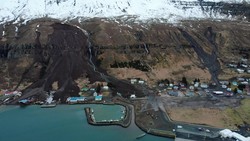The landslide in Seyðisfjörður is the largest landslide to have damaged an urban area in Iceland
Increased monitoring of the mountain slopes above Seyðisfjörður and emphasis on strengthening defence structures
From 15 to 18 December 2020, several landslides hit the town of Seyðisfjörður, destroying or damaging more than 10 buildings. Thankfully, there were no injuries. The largest landslide occurred on 15 December, and it ranks as the most damaging landslide to have affected an urban area in Iceland.
In a recent meeting hosted by the Department of Civil Protection and Emergency Management, the Natural Catastrophe Insurance Fund of Iceland, Iceland State Electricity, the Icelandic Met Office (IMO), and residents of Seyðisfjörður, IMO experts reviewed the background to the events and the extent of the landslides. IMO is responsible for hazard and risk assessment for natural hazards in Iceland.
In the days preceding the landslides, IMO had warned of an increased possibility of landslides and rockfalls in the East Fjords. Ahead of the mudslides, intense rainfall had occurred in the area, with 569 mm of cumulative rainfall between 14 and 18 December – the heaviest rainfall measured over a five-day period in Iceland. In comparison, the average annual rainfall in Reykjavík is about 860 mm.

Hourly, daily, and accumulated precipitation in Seyðisfjörður since early October 2020. The five days of precipitation is unprecedented – such an extreme amount has not been measured before in Iceland.
Unprecedented landslide in a populated area in Iceland
On Friday 18 December 2020, a huge landslide fell through the area just outside Búðará river in Seyðisfjörður, causing enormous damage to more than 10 houses. The town had been evacuated on both sides of the river, but not the entire area where the landslide occurred. First responders and several residents were in the area, some barely escaping the landslide. According to Harpa, the landslide was of a different nature than the landslides that occurred earlier in the week. "The preliminary observations show a landslide scar that is up to 20 m high, and it seems to reach deep into sediments that have not collapsed for millennia. We did not expect a landslide of this magnitude and we underestimated conditions at the site where the landslide fell. Although landslides were expected, geological analyses had not indicated traces of large prehistoric landslides in this area", said Harpa. "The situation was quickly reassessed after the landslide, based on conditions that had not existed for hundreds or even thousands of years," said Harpa.

Extent of the largest landslide where
it entered the sea.(Photo: National Commissioner's Special Forces)
Unstable slopes for some time
Increased monitoring of slopes above Seyðisfjörður
At the meeting with local residents, IMO experts noted the importance of setting up measuring equipment for real-time monitoring of the slopes above the town. The preparation has begun already, and a decision is expected soon on the kind of equipment needed. Plans are being made for the installation of equipment that transmits real-time information on soil movements and water levels in boreholes. Such monitoring will greatly improve the safety of the local population.

Outlines of the December landslides in Seyðisfjörður, eastern Iceland.
Risk assessment to be reviewed and safety to be improved
Landslide hazards originate from different heights on the slopes above the southern part of Seyðisfjörður. The best known hazardous areas are under Strandartindur, where landslides have previously caused damage to settlements on the coast, located underneath the steep slopes. Landslides in this area originate mostly from thick glacial sediments in Strandartindur.
Safety preparedness following the landslides in December is based on assessment of the imminent risk of landslides of various kinds. The first priority is to assess the risk of a very large landslide, comparable to prehistoric landslides, originating from three main pathways on the mountain side. Secondly, further landslides are expected from the fractured sides of the recent, large landslide, where cracks have opened. Thirdly, landslides similar to those sourced from the Botnabrún brook area between the main waterways. This is the entire Botnabrún from Skuldarlækur brook to Dagmálalækur brook. Lastly, smaller soil or surface landslides can occur on steep slopes; these are comparable to the landslides that have occurred in several places in recent weeks, as shown on the map above.




